Ladies we Love: Mountain Guide Emilie Drinkwater
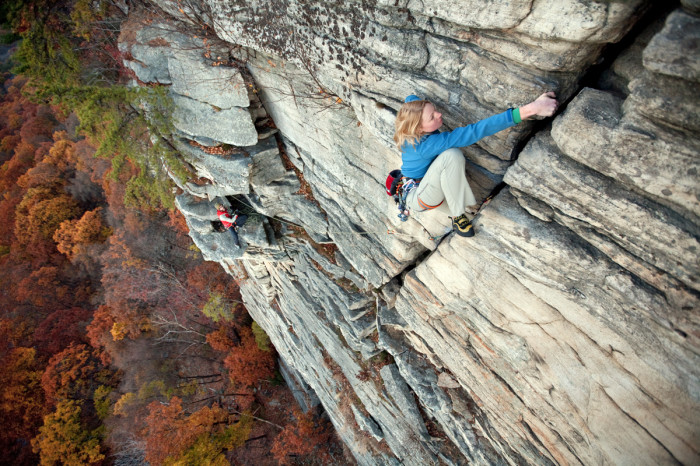
[This Ladies we Love profile is the ninth installment in our monthly series featuring the highly inspiring roster of female athlete ambassadors from Outdoor Research. They are skiers, climbers, mountaineers, and more—all breaking down barriers and pushing the edge.]
Sponsored Love from
For AMGA mountain guide Emilie Drinkwater, mountain climbing is “completely engaging and slightly stressful on all levels.”
This guide service owner based in New York’s Adirondack Park is driven by the mental and physical problem solving with the added challenges of fear, discomfort, and pure difficulty in movement.
“In the mountains I’m at my most productive and focused because these things exist (whereas in daily life I can be prone to boredom and distraction—perhaps known as ADD),” she says. “These challenges are not only what drive me to climb, but what keep me coming back for more.”
Here, we catch up with Emilie—whose guiding lifestyle has taken her from the Adirondacks to Asia in pursuit of exploration and adventure—to learn a few fun facts about her life, including the best (and worst) things about living free and wild in a yurt.
WomensMovement.com: Favorite in-your-ski-jacket energy snack?
Emilie Drinkwater: Nuts and seeds (almonds, cashews, pepitas). And caffeine, whatever form fits in a pocket. I far exceed recommended daily allowances on all the above.
WM: Fav recovery meal?
Emilie Drinkwater: Depends on the trip and the exertion level. Coming off Denali (for example) I want salad, fruit, yogurt, and water without things floating in it. After a cold day of ski touring or ice climbing I want bread, cheese, and chocolate. And beer…no matter the trip.
WM: Book you’re reading right now?
Emilie Drinkwater: Always more than one at a time. Right now that would be Freya Stark’s The Valleys of the Assassins and The Tiger: A True Story of Vengeance and Survival by John Vaillant. Both are fascinating.
WM: Tune playing in your car right now?
Emilie Drinkwater: “Babylon of the Occident” by The Shangai Restoration Project.
WM: What do you love about guiding?
Emilie Drinkwater: Lots of things! Guiding incorporates athleticism, interpersonal skills, intuition, thoughtful decision making, and the opportunity to work with all types of personalities. Additionally, it’s a very dynamic job; from guests to discipline (rock, alpine, or ski) and weather to terrain, something is always changing which means it’s really never boring!
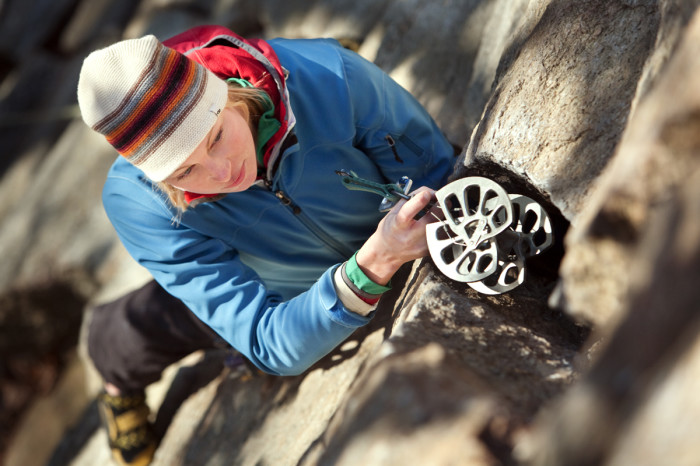
Photo: Tomás Donoso, www.tomasdonoso.com
WM: What freedoms do you gain from living in a yurt?
Emilie Drinkwater: Our yurt is remote (walk or ATV access up a steep streambed) and completely off the grid; no water, no electricity, no internet. While this may sound desperate, there are a lot of freedoms gained in not having any of these everyday resources. The reality is, it’s actually quite easy to adapt once you forget that conventional amenities ever existed in the first place. Living this way is largely why I’m able to travel (mostly for work, sometimes leisure) so extensively. It’s fairly easy to walk away for months at a time when your home is technically classified as a ‘semi-permanent structure’ anyway.
WM: Best thing about the yurt?
Emilie Drinkwater: It’s free! The yurt and land are paid off so we’ll always have a home base, a place to store gear, and somewhere to return to. Worst thing? It’s a lot of work –basically a part time job – especially in winter. There’s always wood to be split, water and propane to be hauled, a wet and/or icy streambed/driveway to contend with, and something to be fixed or improved upon (but I guess that’s just home ownership in general).
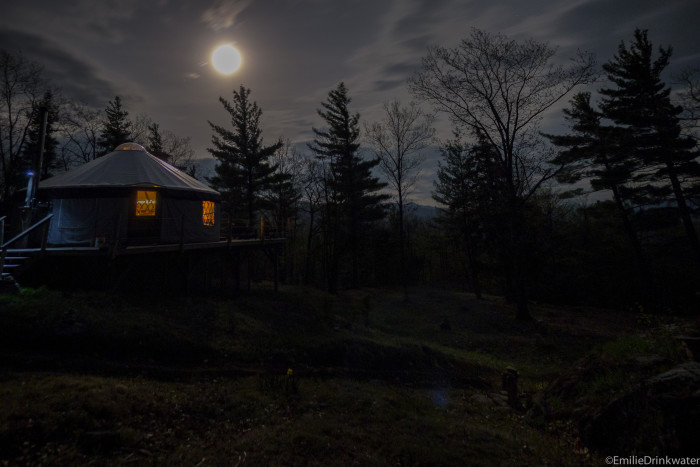
Emilie’s yurt under the full moon.
WM: Fav place to climb?
Emilie Drinkwater: My favorite climbing destinations are usually the result of great partners as much as the climbing itself. That said, stand out venues include Joshua Tree, Silver Lake (Adirondacks), and the little bit of climbing I’ve done in the Alps. Actually, other than run-out friction slabs, I pretty much find great enjoyment in all climbs, everywhere.
WM: What was it like to nail down several first ascents?
Emilie Drinkwater: In the Indian Karakoram as part of the expedition to climb Saser Kangri II? Not that easy! If you’ve ever been on a climbing expedition, particularly at high altitude, you recognize that failure is often more probable than success.
Janet, Kirsten, and I made several attempts on our initial objective (Peak 6285′) before deciding it was simply too dangerous given the conditions. Walking away from that was really hard but also an important learning opportunity (failure usually is). After deciding to move our advanced basecamp to a completely different glacier—where the higher and colder mountains live (Saser Kangri II)—we did succeed in climbing three new peaks but only days before the end of our trip. And those didn’t come easily either!
On Pumo Kangri, Kirsten and I (Janet was sick) significantly underestimated what we were up for and what started as a quick exploratory ski objective suddenly became a 30-hour push. We ended up ditching our skis (too icy, too steep) and opted to continue climbing but un-roped since our ‘light and fast’ ski mountaineering plans left us with little gear. Out of food and water, we summitted at dark and, with one rope, one ice screw, and one working headlamp proceeded to descend through the night and well into the next day. All in all a great adventure and a phenomenal team of climbers to spend the summer with.
Hardest part? Struggling with altitude and acclimatization. I pretty much felt sick and sluggish for the entire trip.
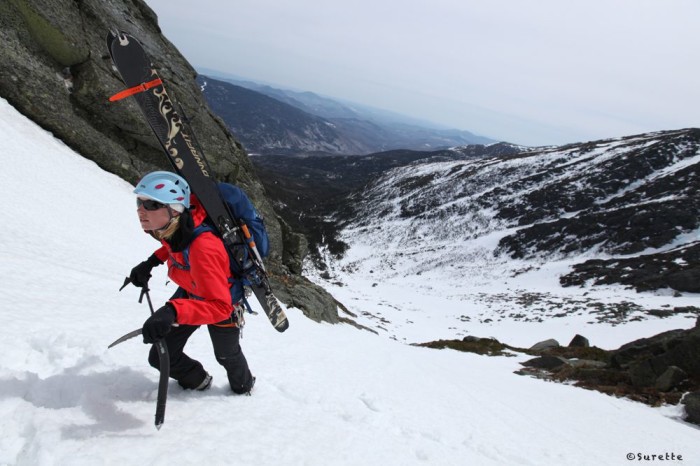
Photo: Jim Surette
WM: Scariest climbing experience?
Emilie Drinkwater: On any given day, something in the mountains succeeds in scaring me, rational or not. But one particular occasion does stand out: In my early 20’s I was kind of into solo-aiding and backyard exploration and had decided to solo a remote, backcountry aid line on Wallface (NY’s largest cliff at nearly1000′).
Near the top, after having been at it all day in the wind and rain and having been benighted for hours, I was in free climbing mode but struggling to make the final wet friction moves. There was a wide, mud filled crack in front of me but it offered no protection. I’d been balanced on some slabby holds for what seemed like hours and just couldn’t seem to move up or down.
And then sure enough, my feet started to slide. I clawed desperately at the mud filled crack but to no avail. I was gaining speed but still standing, trying not to tip over backwards initiating what would certainly be a very, very bad fall as my last piece, a tipped out green Alien was more than 60′ below me. I remember having enough time to think about how it was going to feel hanging on the end of my rope, 600′ off the ground after a tumbling fall over blocks and ledges, then over a roof, and into an airy abyss, alone in the rain and dark. And that was the best case scenario!
Or so I thought because, remarkably, after about 10′, I came to a sudden, unexpected stop. My right foot had caught on the slightest scoop of coarse rock and there I stayed, terrified that the slightest movement would continue the fall. As I delicately shone my headlamp around, there, right in front of me was a tiny seam. I stuffed it full of marginal RP’s and made a run for the top.
To this day I wonder what higher powers provided that hidden seam and scooped foot hold on a cold, rainy Halloween night.
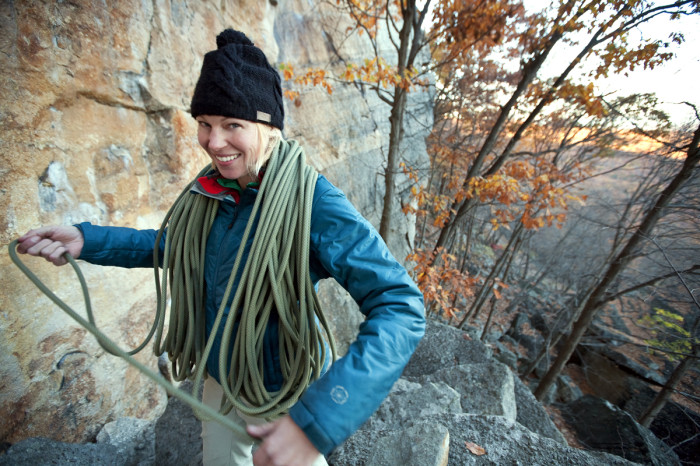
Emilie Drinkwater climbing in the Gunks. Photo: Tomás Donoso, www.tomasdonoso.com
Kamagra oral jelly Online something to buy the most convenient way. He doesn’t demand from you any actions except how to visit the website. And in separate with goods necessary to you to put the end. To specify your address and to wait for the supplier to whom you will give money.



November 10th, 2014 at 5:20 pm
I live in the same town in the Adirondacks as Emily and always enjoy hearing about her escapades.
December 2nd, 2014 at 10:31 pm
That’s so cool, Lorraine…you live in a beautiful place! Thanks for visiting WomensMovement.com!